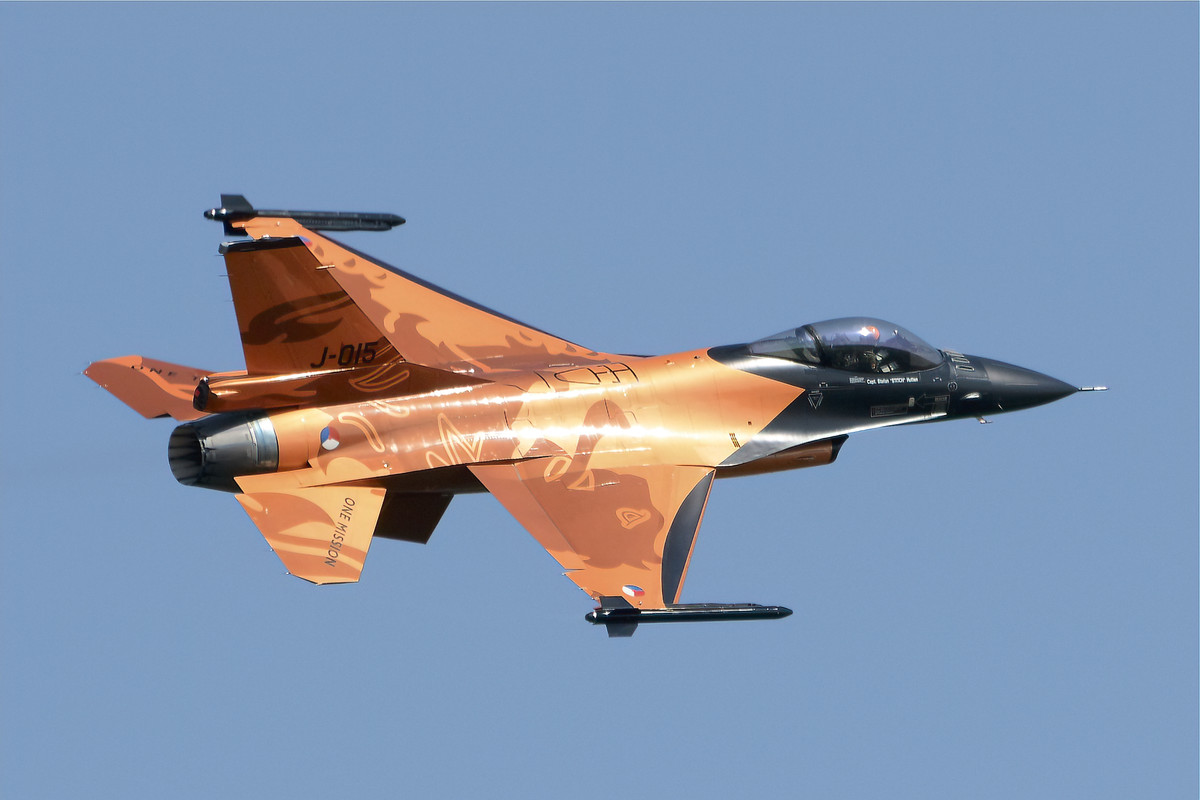
Royal Netherlands Air Force F-16 Demo Team
F-16 Solo Display
The Royal Netherlands Air Force F-16 Solo Display Team was a distinguished aerobatic group renowned for showcasing the exceptional capabilities of the F-16 Fighting Falcon. Established in 1979 with a debut performance at Twente Air Base, the team quickly gained prominence, performing at air shows across Europe and the United States. Their dynamic displays captivated audiences, emphasizing the agility, speed, and power of the F-16, while their precision and professionalism reflected the high standards of the Royal Netherlands Air Force. Notably, their excellence was recognized with a prize for the best display team in the jet category at the 2009 air show at Reims – Champagne Air Base.
The team’s performances went beyond mere aerobatics, serving as a testament to the coordination and operational skill within the Royal Netherlands Air Force. Pilots and ground crew were consistently drawn from active squadrons, bringing real-world military experience to each show. This practice of rotating personnel from various squadrons ensured a steady infusion of fresh talent and diverse expertise, enhancing the team’s adaptability and maintaining its reputation for thrilling, well-executed routines.
Over the years, the team operated from multiple locations, including a long stint at Volkel Air Base before relocating to Leeuwarden Air Base in 2014. One of its final pilots, Kapitein Jeroen “Slick” Dickens, flew the distinctive orange F-16, J-015, which became a hallmark of the team’s later years. This mobility across bases and squadrons underscored the team’s flexibility and the depth of skill within the air force.
Visually, the team evolved its identity, with the striking orange livery introduced in 2009 becoming an iconic symbol of Dutch pride and the excitement of their displays. However, challenges emerged in the mid-2010s due to personnel and resource shortages, leading to inactivity in 2015 and permanent disbandment in 2018. Though their time in the skies ended, the F-16 Solo Display Team left an enduring legacy, remembered for their breathtaking performances and contributions to military aviation and air show heritage.
About the F-16
The F-16 Fighting Falcon is a single-engine multirole fighter aircraft originally developed by General Dynamics (now Lockheed Martin) for the United States Air Force (USAF). Its origins trace back to the Lightweight Fighter program of the early 1970s, which aimed to create a cost-effective, high-performance aircraft to complement the larger F-15 Eagle. Designed initially as an air superiority day fighter, the F-16 evolved into a versatile all-weather aircraft capable of a wide range of missions. The prototype first flew in 1974, and the aircraft officially entered service in 1978, with production beginning in 1976. Since then, over 4,600 F-16s have been built, making it one of the most successful fighter jets in history.
The F-16 is renowned for its agility, advanced avionics, and adaptability, featuring a fly-by-wire flight control system—a first for a production fighter aircraft. It has been widely exported to over 25 countries and has seen extensive combat in conflicts such as the Gulf War, the Balkans, and operations in Afghanistan and Iraq. Its versatility allows it to perform roles including air-to-air combat, precision ground strikes, and reconnaissance. The aircraft’s design includes a single vertical tail, a bubble canopy for excellent visibility, and a powerful engine (typically a Pratt & Whitney or General Electric turbofan), enabling speeds exceeding Mach 2.
Over its decades-long service life, the F-16 has undergone numerous upgrades to remain competitive in modern warfare. Variants like the Mid-Life Update (MLU) and the advanced F-16V have introduced improved radar, avionics, and weapons systems. The aircraft’s affordability and performance have made it a cornerstone of many air forces worldwide, with production continuing into the 21st century for international customers. Its combat-proven reliability and continuous evolution have solidified the F-16’s legacy as a pivotal aircraft in military aviation history.
Specifications
Crew
1 F-16C / 2 F-16D
Length
49 ft 5 in (15.06 m)
Wingspan
32 ft 8 in (9.96 m)
Height
16 ft (4.9 m)
Max Speed
Mach 2.05 (2,178 km/h; 1,353 mph; 1,176 kn)
Combat Range
295 nmi (339 mi, 546 km)
Service Ceiling
50,000 ft (15,000 m)
Thrust/weight
1.095
F-16 in the Royal Netherlands Air Force
The Royal Netherlands Air Force (RNLAF) became one of the earliest international operators of the F-16, joining Belgium, Denmark, and Norway in the European Participating Air Forces consortium to acquire the aircraft. The Netherlands ordered 102 F-16A/B Block 15 aircraft in the late 1970s, with deliveries starting in 1979. These jets, assembled locally by Fokker under license, replaced aging aircraft like the F-104 Starfighter and were initially focused on air defense and NATO commitments during the Cold War. Over the years, the Dutch F-16s played a significant role in international operations, including peacekeeping missions in the former Yugoslavia and combat deployments in Afghanistan and Iraq.
In the 1990s, the RNLAF upgraded its F-16 fleet to the Mid-Life Update (MLU) standard, enhancing their avionics, radar, and weapons capabilities to meet modern demands. This allowed the aircraft to remain a key asset in Dutch military aviation for decades. However, by 2019, the RNLAF began transitioning to the F-35A Lightning II, signaling the gradual phase-out of its F-16s. The retirement process culminated in September 2024, when the last Dutch F-16s were decommissioned after 45 years of service. A farewell flypast marked the occasion, and while some aircraft were donated to Ukraine or reserved for training and museum purposes, the retirement closed a significant chapter in the Netherlands’ air force history.
Did You Know?
- The F-16 was the first fighter aircraft to use a fly-by-wire flight control system, replacing traditional mechanical linkages with electronic controls for unmatched agility.
- The F-16's bubble canopy isn’t just for looks—it gives pilots a rare 360-degree field of view, a feature few other fighters can match.
- Despite being a single-engine jet, the F-16 can pull 9G turns, a feat that tests both the aircraft’s structure and the pilot’s endurance.
- The F-16 has moonlighted as a NASA testbed, helping develop cutting-edge flight control systems beyond its combat role.
- Over 100,000 combat missions have been flown by F-16s since 1978, a staggering number that highlights its durability across decades of conflict.
Inactive Status
On December 17, 2018, it was announced that the F-16 Solo Display Team had been permanently disbanded, having been inactive since 2015 due to personnel and material shortages.
Test Your Knowledge
1. In what year did the F-16 first take flight?








